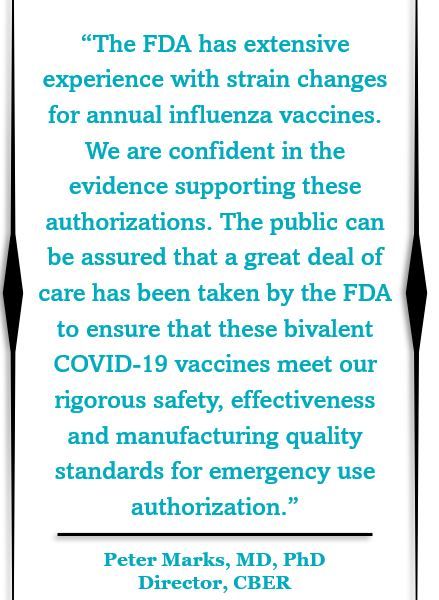
- Clinical Technology
- Adult Immunization
- Hepatology
- Pediatric Immunization
- Screening
- Psychiatry
- Allergy
- Women's Health
- Cardiology
- Pediatrics
- Dermatology
- Endocrinology
- Pain Management
- Gastroenterology
- Infectious Disease
- Obesity Medicine
- Rheumatology
- Nephrology
- Neurology
- Pulmonology
FDA Authorizes Pfizer and Moderna Updated COVID-19 Booster Shots
The FDA EUA amendments for updated booster vaccinations are based on clinical studies of the omicron BA.1 variant and preclinical data on the BA.4 and BA.5 variants.
The US Food and Drug Administration (FDA) today announced amendments to emergency use authorizations (EUA) of both the Moderna and Pfizer-BioNTech COVID-19 vaccines to authorize single booster doses of bivalent formulations targeting the BA.4 and BA.5 omicron variants of the SARS-CoV-2 virus.
Together these subvariants are the cause of most US cases of COVID-19 and are predicted to continue circulating this fall and winter.
The “updated boosters” contain mRNA components of the original SARS-CoV-2 strain and of 1 strain common to both BA.4 and BA.5 lineages of the omicron variant. The updated shots may be administered at least 2 months after primary or booster vaccination, with the Moderna bivalent formulation authorized for use in individuals aged ≥18 years and the Pfizer-BioNTech authorized for those aged ≥12 years, according to the FDA.
“The FDA has been planning for the possibility that the composition of the COVID-19 vaccines would need to be modified to address circulating variants. We sought input from our outside experts on the inclusion of an omicron component in COVID-19 boosters to provide better protection against COVID-19,” said Peter Marks, MD, PhD, director of the FDA’s Center for Biologics Evaluation and Research, in the FDA announcement.
FDA Commissioner Robert M Califf, MD, noted “As we head into fall and begin to spend more time indoors, we strongly encourage anyone who is eligible to consider receiving a booster dose with a bivalent COVID-19 vaccine to provide better protection against currently circulating variants.”
Totality of evidence

The FDA’s decision to amend the EUA for each bivalent boosters is based on the totality of available evidence, the agency says, including extensive existing safety and efficacy data for each of the original monovalent mRNA vaccines, safety and immunogenicity data obtained from a clinical study of a booster dose of a bivalent vaccine that contained material from the original strain of SARS-CoV-2 and a component of the omicron BA.1 lineage, similar to each of the vaccines now authorized, as well as nonclinical data on the BA.4 and BA.5 lineages of the omicron variant.
Efficacy of the Moderna bivalent updated booster was analyzed in adults who had completed the 2-dose primary series with and received 1 booster dose of the monovalent COVID-19 vaccine. Particpants recieved a second booster of either the monovalent or bivalent vaccine at least 3 months following the first. The immune response against BA.1 at 28 days was stronger with the bivalent shot than with the monovalent. Safety of the bivalent vaccine was evaluated in a similar study with side effects reflecting those typically seen with the original monovalent shot.
Design of the Pfizer bivalent booster efficacy study mirrored the Moderna evaluation with the primary difference being the interval after completion of the original 2-dose series-plus-booster. The second booster, either the original monovalent vaccine or the investigational bivalent formulation, was administered 4.7 to 13.1 months after the booster. As with the Moderna study, the immune response against BA.1 when measured after 30 days was more robust with the bivalent than the monovalent vaccine. Side effects associated with the former were similar to those with the latter and not reported as severe, eg, pain, erythema, swelling at the injection site, fatigue, headache, muscle pain, fever.
In its announcement last week of the company’s submission for the EUA, Pfizer said the updated booster would be available to ship immediately. Moderna, in an announcement today said its booster would be ready to ship in the next few days.
Speaking to the New York Times, Mercedes Carnethon, an epidemiologist at Northwestern University’s Feinberg School of Medicine said, “Covid-19 is the third leading cause of death in the United States. And it’s as if we’ve just accepted that that is going to be the case. I really hope as many people as possible will seek the updated booster so we can protect those who will have a terrible outcome.”
“Covid-19 is the third leading cause of death in the United States...I really hope as many people as possible will seek the updated booster so we can protect those who will have a terrible outcome.”
With today’s authorization, according to the FDA, EUAs for both vaccines will be revised to remove the use of the monovalent vaccines for booster administration for individuals aged ≥18 years (Moderna) and ≥12 years (Pfizer-BioNTech). They will remain in use, however, as the primary vaccines for anyone aged ≥6 months, and the Pfizer-BioNTech vaccine remains authorized for a single booster dose for patients 5 through 11 years of age, at least 5 months after completing a primary series with the Pfizer-BioNTech COVID-19 vaccine.
FDA Approves Updated Indication Statement for Upadacitinib in Inflammatory Bowel Disease Treatment
October 14th 2025FDA approves updated indication for upadacitinib in ulcerative colitis and Crohn disease treatment, allowing use after one systemic therapy when TNF blockers are clinically inadvisable.
FDA Approves Updated Indication Statement for Upadacitinib in Inflammatory Bowel Disease Treatment
October 14th 2025FDA approves updated indication for upadacitinib in ulcerative colitis and Crohn disease treatment, allowing use after one systemic therapy when TNF blockers are clinically inadvisable.
2 Commerce Drive
Cranbury, NJ 08512
All rights reserved.